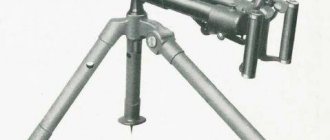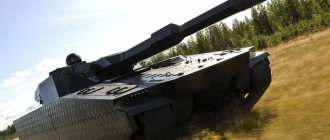Family of anti-personnel fragmentation mines POM-2 "Otek"
The POM-1 anti-personnel fragmentation mine made it possible to solve a number of problems associated with the creation of minefields, but was not without serious shortcomings that complicated its operation. For this reason, it was decided to develop a new ammunition of a similar purpose, which does not have similar problems and is capable of solving the assigned tasks. The result of the implementation of the new project was the POM-2 “Otek” mine. Like POM-1, “Anti-personnel fragmentation mine, the second” was developed by the Scientific Research Engineering Institute. This time, Soviet specialists did not take into account foreign experience, but used their own ideas and built the project exclusively on them. The new project planned to create a promising anti-personnel mine with sufficient power, as well as the ability to be installed on different surfaces using remote mining systems. In addition, it was planned to remove parts from the mine equipment, due to which the previous POM-1 had a limited service life.
The POM-2 "Otek" mine is intended for installation using automated systems, which affected the composition of its equipment and layout. In the transport position, this product is located inside a special metal cup with a set of parts for proper descent to the ground and subsequent installation. In the transport position, the mine has a diameter of about 6.5 cm and a height of about 18 cm. The total weight of the product is 1.6 kg. The dimensions and weight of the Otek mine were determined in accordance with the requirements of existing remote mining systems.
POM-2 mine in combat position. Photo: Wikimedia Commons
The ejector cup is a cylinder open at one end, which contains a pyrotechnic ejector and a braking parachute-stabilizer. The latter is a metal base with six nylon strips 440 mm long. The purpose of the stabilizer is to slow down the mine when it falls, as well as to ensure the correct position when falling on the ground. The glass also comes with two separate lids.
The mine itself is located inside the glass. It has a cylindrical body of smaller height, equipped with an explosive charge, a fuse and an installation device. The latter consists of six spring-loaded legs made in the form of curved plates with perforations. When released from the glass, they unfold and bring the mine body into a vertical position, ensuring optimal distribution of fragments when the main charge is detonated.
The body of the mine is a fragmentation jacket, the crushing of which produces a large number of damaging elements. In the upper part of the body there is a fuse and target sensors with a system for their release. The latter contains a special shootable block, as well as four anchors with threads.
Scheme of the POM-2 mine. On top is a glass (left) and a mine without it (right). In the center is a mine in firing position. Drawing Saperka.ru
An important feature of the POM-2 mine is the architecture of the fuse and self-destructor. There are no electrical components in their design, due to which the shelf life and combat service life, in comparison with POM-1, increases several times. The VP-09S fuse has a mechanical design, while the self-liquidator has a hydromechanical design. Both of these mechanisms can operate stably under various conditions, although some of their parameters directly depend on environmental conditions.
Having a relatively small size, the POM-2 mine is equipped with a charge weighing 140 g and in this parameter surpasses its predecessor. This fact, as well as other design features, ensure superiority in other characteristics, as well as in overall combat effectiveness.
The first version of the Otek anti-personnel mines was not intended to be installed manually. The creation of minefields using these weapons is carried out using cassettes and corresponding launching devices. POM-2 mines are placed in KPOM-2 cassettes, four in each. The cassettes, in turn, can be loaded into launchers of aviation (VSM-1) or ground (UZM) remote mining systems. These devices are responsible for the release of mines and their subsequent installation.
Mine section. Drawing Saperka.ru
The parameters of a minefield installed using remote mining equipment depend on a number of factors, primarily on the number of cassettes and the speed of movement of the minelayer. Thus, a minelayer of the UMZ type on a wheeled chassis, equipped with special launchers, is capable of laying a minefield along the front up to 5 km long at a depth of 60-140 m. In this case, it is possible to install a two-lane field. It takes 720 mines of the “Otek” type to create such a barrier.
A helicopter or land minelayer throws POM-2 mines in a KPOM-2 cassette. At a given height, the cassette opens and throws out mines. Immediately after leaving the cassette, the mine glass throws off one of the covers, which leads to the release of the tape stabilizer. Six nylon tapes ensure the descent of the mine along a trajectory close to vertical, and also reduce the speed of its fall. According to available data, the Edema product remains operational when dropped onto the ground at speeds of up to 60 m/s.
With the help of a stabilizer, the mine falls to the ground and ends up in a vertical or horizontal position. When falling, the pyrotechnic moderator ignites, which “counts down” 50 seconds and gives the command to drop the glass. A separate powder expelling charge pushes the mine out of the cup and throws them away from each other. In this case, the second moderator ignites, which is designed for 3-4 s. After it burns out, the mine drops another cover, as a result of which the legs of the installation device are released.
Under the action of springs, the legs open and take a horizontal position, lifting the body of the mine into a vertical position. The mine remains in this position until it is triggered or self-destructed. 1.5-2 s after rising to a vertical position, the target sensor anchors are fired. To do this, a powder charge ejects a special block of complex shape, on which four anchors are attached. Having risen 0.5 m above the mine, the block shoots off and scatters anchors to the sides, which stretch 10-meter threads.
A mock-up of a mine, simulating a weapon during the cocking process. So, the anchor block has not yet been dropped. Still from TV show “Military Acceptance” of the “Zvezda” channel
The threads are connected at one end to the anchors. Their other ends are attached to two fuse pins, which serve as a target sensor. When one of the threads is tensioned with a force of about 0.3 kg, the sensor pin moves, after which the fuse detonates the main charge. Under the influence of the energy of the explosion, the mine body is crushed into a large number of fragments, ensuring continuous destruction of manpower within a radius of 6-8 m (according to other sources, up to 15-16 m).
The POM-2 mine is equipped with a hydromechanical self-destruction mechanism, which, depending on environmental conditions, ensures self-detonation in the interval from 4 to 100 hours from the moment of installation. The countdown to liquidation begins after the scattering of anchors with threads.
Anti-personnel mines POM-2 "Otek" have a fairly high efficiency and are superior in this parameter to the previous POM-1. Effective use is ensured by an increased charge and an optimized body shape that breaks into fragments. The cylindrical shape of the body, as opposed to the spherical one, directs most of the fragments away from the mine, and the number of damaging elements that fall into the ground or fly vertically upward is significantly reduced.
The head of a training mine in a combat position. Still from TV show “Military Acceptance” of the “Zvezda” channel
The Oteka design does not contain any devices that would make it difficult to neutralize this weapon, but the mine is considered indestructible. Detecting such munitions is an extremely difficult task, especially since the mines are laid in groups over large areas of terrain. During installation, mines are scattered in different directions by target sensor threads with high sensitivity. The threads form a dense network and can also intertwine with each other, making movement through the minefield impossible: any careless step can lead to the detonation of at least one mine. In addition, in a number of situations, the simultaneous detonation of several ammunition cannot be ruled out, which leads to an increase in the affected area.
Due to the sensitive target sensor and long threads, clearing minefields based on POM-2 mines is only possible using extended charges or by repeatedly driving through armored vehicles with the appropriate level of protection. Demining by other means is impractical or deadly.
One of the main differences between the POM-2 mine and the previous POM-1 is the absence of any sources of electricity and electrical components. All processes of preparation for work and detonation are carried out using powder charges, tension energy of threads, etc. Thanks to this, the guaranteed shelf life of Otek mines reaches 10 years - twice as long as that of POM-1 under ideal conditions. Let us remind you that POM-1 needed to be stored under certain conditions, in particular, a warm warehouse was required. Otherwise, self-discharge of batteries could accelerate, reducing the shelf life of ammunition.
Mine POM-2R disassembled. From left to right: glass, lids (top), mine and URP device. Photo Sniper-weapon.ru
In the nineties, a new modification of the Otek mine called POM-2R was developed. The letter "P" means "Manual". The main goal of the new project was to ensure the installation of mines manually. This installation method is not very effective, however, in some cases, the POM-2 mine with similar capabilities can be useful for solving some specific problems, primarily for organizing small minefields, for example, along the route of enemy fighters.
The POM-2R mine is a slightly modified POM-2. The main difference is the absence of a stabilizer and the design of the glass has been modified accordingly. In addition, a “manual” mine must be used in conjunction with a special URP device that ensures its installation without the use of automated means.
The URP product is a plastic cup with four slots on the walls, on the bottom of which there is a pinning mechanism. The design of the latter includes an igniter primer, a firing pin, a mainspring and some other parts.
Location of “manual” mines and URP in the closure. Photo Grossfater-m.livejournal.com
Before installing the POM-2R mine, you should put the URP device on it. For better fixation, a metal ring is provided on the plastic case. After this, the union nut of the pinning mechanism is removed and the nylon thread is pulled out, then the mine is installed in the right place. The position of the mine does not matter, since it is equipped with an installation device. If necessary, POM-2R mines with URP devices can be installed on the move or from a moving vehicle. In this case, they can simply be thrown onto the ground after removing the thread. All other operations to prepare for work are carried out automatically.
Removing the thread leads to the unlocking of the striker, which hits the igniter primer and triggers the mine's cocking mechanisms. After the corresponding moderator burns out, the mine is fired from the cup and the URP device is reset. After this, the mine unfolds its legs, rises to a vertical position and scatters target sensor threads. In this respect, POM-2 and POM-2R do not differ from each other.
“Manual” mines are supplied in foam closures, each of which contains four ammunition and the same number of URP devices. In this form, the weapon is called the “KRM-P anti-personnel manual mining kit.”
The POM-2R combat anti-personnel mine can be produced in several modifications with different characteristics. Thus, the POM-2R1 product is distinguished by its increased time to 120 with the time of transfer to the combat position, and the POM-2RBS and POM-2R1BS are modifications of the POM-2R and POM-2R1 without a self-liquidator. At the same time, the preparation time for work corresponds to the basic modifications.
Mine in position. Four target sensor threads are visible. Still from TV show “Military Acceptance” of the “Zvezda” channel
As part of the Otek family, several training mines with different compositions of components were created. The UI-POM-2-1 product differs from a combat mine in the absence of a detonator cap and a detonator. The UI-POM-2-2 mine has pyrotechnic elements, but is not equipped with a main charge, and UI-POM-2-3 carries a smoke charge instead of TNT and has holes in the body. Such ammunition signals its activation by thick smoke.
For training in the use of “manual” mines, a practical product UI-POM-2R, a mine with a smoke charge UI-POM-2RD and an inert mine UI-POM-2RDP with pyrotechnic elements are offered. For obvious reasons, all training modifications are not equipped with a self-liquidator.
Anti-personnel fragmentation mines of the POM-2 family have been in service with the Russian army over the past several decades and are actively used by engineering troops. This weapon is rated as one of the best domestic systems in its class, since it compares favorably with its predecessors in ease of installation and high combat qualities. In addition, there are a number of important advantages over the POM-1 mine, which is similar to the POM-2 in some features.
According to some reports, POM-2 mines are still in mass production and supplied to the troops. At the same time, the Research Engineering Institute is working on the development of anti-personnel weapons. Not so long ago it became known about the existence of a new project POM-3 “Medallion”, which uses some of the developments on “Otek”. Moreover, the development of mine weapons continues. In the foreseeable future, new models of such weapons with even higher characteristics should appear.
Based on materials from the sites: https://saper.etel.ru/ https://eragun.org/ https://saperka.ru/ https://sniper-weapon.ru/ https://grossfater-m.livejournal. com/
KRM-T anti-tank manual mining kit with PTM-4R anti-tank mine
Volumetric explosion ammunition
The set is designed for manual anti-tank mining with the PTM-4R mine, which hits all modern tanks from the bottom under the entire projection.
Composition of the KRM-T kit:
- mine PTM-4R;
- manual starting device URP-T
- UVS installer;
- package.
Performance characteristics:
| Total weight, kg | 3,5 |
| Overall size, mm | 390x69x118 |
| Weight of explosive mine PTM-4R (TG-40), kg | 1,4 |
| Installation of the kit | on the surface of the earth and in the ground |
| Set self-destruction time, hour | 8, 12, 24, 48 |
| Self-deactivation time, days | 120 |
| Long-range cocking time, sec | 40-80 |
| Temperature range of application, °C | -40 to +50 |
| Guaranteed shelf life, years | 10 |
Performance characteristics:
| Cassette weight, kg | 9,6 |
| Weight of expelling charge, kg | 0,01 |
| Overall dimensions, mm: | |
| 48 | |
| 140 | |
| Number of PTM-4 mines in a cassette, pcs. | 2 |
| Mine weight, kg | 3,25±0,25 |
| Explosive charge mass, kg | 1,4 |
| Explosive type | TG-40 |
| Fuse type | non-contact magnetic VT-14, with programmable self-liquidator |
Overall dimensions of the mine, mm:
| 350 110 55 |
| Long-range cocking time, sec | 40÷80 |
| Self-destruction time adjustable, hour | 6; 12; 24; 48 |
| Installation Tools | helicopter mining system VSM-1, universal minelayer UMZ, portable mining kit PKM |
| Temperature range of application, ºС | -40÷ +50 |
| Guaranteed shelf life, years | 10 |
KRM-T anti-tank manual mining kit with PTM-4R anti-tank mine
The kit is designed for manual anti-tank mining with the PTM-4R mine, which hits all modern tanks from the bottom under the entire projection.
Composition of the KRM-T kit:
- mine PTM-4R;
- manual starting device URP-T
- UVS installer;
- package.
Performance characteristics:
| Total weight, kg | 3,5 |
| Overall size, mm | 390x69x118 |
| Weight of explosive mine PTM-4R (TG-40), kg | 1,4 |
| Installation of the kit | on the surface of the earth and in the ground |
| Set self-destruction time, hour | 8, 12, 24, 48 |
| Self-deactivation time, days | 120 |
| Long-range cocking time, sec | 40-80 |
| Temperature range of application, °C | -40 to +50 |
| Guaranteed shelf life, years | 10 |
Performance characteristics:
| Cassette weight, kg | 9,6 |
| Weight of expelling charge, kg | 0,01 |
| Overall dimensions, mm: | |
| 48 | |
| 140 | |
| Number of PTM-4 mines in a cassette, pcs. | 2 |
| Mine weight, kg | 3,25±0,25 |
| Explosive charge mass, kg | 1,4 |
| Explosive type | TG-40 |
| Fuse type | non-contact magnetic VT-14, with programmable self-liquidator |
Overall dimensions of the mine, mm:
| 350 110 55 |
| Long-range cocking time, sec | 40÷80 |
| Self-destruction time adjustable, hour | 6; 12; 24; 48 |
| Installation Tools | helicopter mining system VSM-1, universal minelayer UMZ, portable mining kit PKM |
| Temperature range of application, ºС | -40÷ +50 |
| Guaranteed shelf life, years | 10 |










